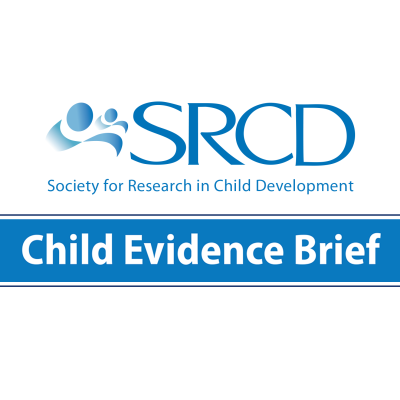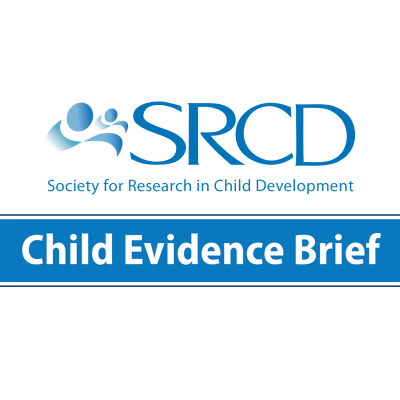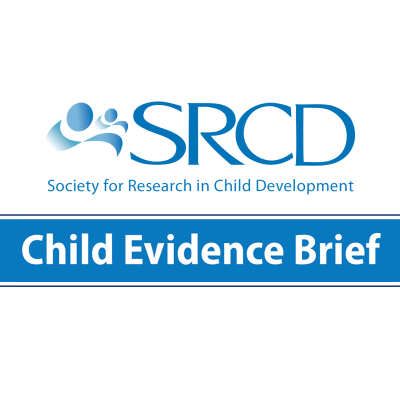Responsible Fatherhood Programs: Children Benefit from a More Integrated Family Approach
Edited by Rebekah Levine Coley, Ph.D., Boston College. For more information, contact the Society for Research in Child Development, at policy@srcd.org.
Authors
- Carolyn Pape Cowan, Ph.D., University of California, Berkeley
- Alan J. Hawkins, Ph.D., Brigham Young University
- Philip A. Cowan, Ph.D., University of California, Berkeley
Nearly 20 million children (almost 1 in 4) live in a home without a resident father.1 These children are more likely to have social-emotional adjustment problems,2 failing grades at school,3 and become involved in the juvenile justice system.4 To address the problems that arise from fathers’ physical or psychological absence from children’s lives, in 2006 the U.S. Congress authorized the Healthy Marriage and Responsible Fatherhood (HMRF) initiative, allocating $150 million per year to two separate programs: Healthy Marriage (HM) programs to strengthen married and unmarried couple relationships; and Responsible Fatherhood (RF) programs to increase the active engagement of non-residential and residential fathers as parents, partners, and economic providers.5 HM programs typically focus on reducing couple conflict rather than fathering or co-parenting.6 While almost all RF programs offer group programs attended and led by men, with a focus on parenting and men’s mental health,7 evidence shows that fatherhood programs that include both parenting partners and expand the curriculum to cover multiple domains of family functioning not only increase father involvement and collaboration between parents, but also reduce harsh parenting and support children’s development.8,9 Together, evidence supports a greater integration of RF and HM programs, the use of expanded curricula that cover multiple aspects of family life, and more attention to assessing the impact of these programs on parents and children.
Positively Involved Fathers Contribute to Children’s Development and Family Functioning
Hundreds of research studies have shown that children fare better when fathers are more available to their children, engage in frequent contact with them, and understand and meet their needs.10 Children with more engaged fathers have higher levels of cognitive skills and academic grades, more positive peer relationships, and fewer behavior and mental health problems.11 Parents also show greater well-being when fathers are actively involved with their children: both parents are less depressed, physically healthier, more satisfied with their relationship, more cooperative, and less likely to undermine each other’s parenting decisions.12,13
Most Responsible Fatherhood Programs Have Shown Small, Positive Effects on Families
Most RF programs include male group leaders and participants. Curricula focus primarily on teaching fathers specific parenting skills and how to cope with feelings of anxiety and depression. Some programs targeting low-income fathers - the primary population in most programs - also focus on improving fathers’ financial stability and increasing child support payments.14 Evaluations of these RF programs reported small increases in fathers’ involvement with their children, collaboration with their co-parents, and income and employment.15,16 However, most RF programs produced very little impact on healthy relationships, parenting skills and behaviors, or children’s well-being.16 Notably, few RF programs included fathers’ co-parents or examined impacts on children,17 despite the primary policy assumption that increasing fathers’ positive involvement would result in improvements in children’s lives.
Responsible Fatherhood Programs That Include Co-Parents and Expanded Curricula Have Greater Impacts
The idea of inviting both parents into RF programs is based in part on consistent evidence that (1) the best predictor of a father’s involvement with his child is the quality of his relationship with the child’s mother, regardless of family structure,18,19 and (2) couple conflict is related to both parents’ negative treatment of their children and children’s behavior problems and academic difficulties.20 Two examples of these expanded programs include:
- Supporting Father Involvement (SFI), a state-funded program for low-income families, required participation by fathers and their co-parents (primarily but not exclusively mothers) in groups led by trained co-leaders. The curriculum covered multiple aspects of family life – parents’ personal distress, relationship quality, parenting strategies, life stress, and the avoidance of repeating negative intergenerational patterns (e.g., absent fathers, harsh parenting behaviors such as hitting). Evaluations in multiple locations found SFI led to reductions in fathers’ and co-parents’ psychological distress, couple conflict and violence, harsh parenting, and children’s acting out and depressed behaviors. Some of the SFI evaluation trials also reported increases in family income or employment.7,21-24
- TRUE Dads is a federally-funded RF program for low-income families with a curriculum that covers multiple domains and an optional workforce component. TRUE Dads improved mental health among fathers and co-parents (e.g., fewer symptoms of depression, anxiety, and anger), decreased destructive couple communication and violent problem-solving (e.g., shouting, physical abuse), and increased fathers’ employment hours and income.25 These benefits were linked with less harsh parenting and less aggressive and depressed behaviors in their children. Benefits of TRUE Dads emerged for parents who were married, cohabiting, or living apart.
In contrast with the limited benefits of fathers-only programs, RF programs that include both parents and expanded curricula result in improvements in most of the central aspects of family life. Consistent with the benefits of these exemplar programs, an international review of hundreds of couple-, fatherhood-, and family-based programs concluded that the few RF programs that offered group sessions for both parenting partners were more effective than father-only programs at improving the quantity and quality of fathers’ family involvement.9
Challenges of Including Co-Parents in Responsible Fatherhood Programs
The idea of including both fathers and co-parents in RF programs is not without its challenges.29 Concerns include recruiting and scheduling both parents, especially when co-parents are not in romantic relationships, and creating safe spaces for fathers’ open discussion with their partners present. Growing evidence provides techniques for overcoming these difficulties and facilitating men’s participation in both RF and HM programs,10 although careful assessments of safety are necessary in families with a history of domestic violence, child abuse, or neglect.29 Two-parent RF programs are not feasible options for fathers without co-parents or when co-parents refuse to participate.
Healthy Marriage Programs Can Also Be Viewed as Father Involvement Programs
Because HM and RF programs have been administered and delivered in separate silos, HM interventions have not been considered as potential resources for enhancing father involvement. A review of 29 HM program evaluations found small but significant improvements in parents’ cooperation in raising their children.6 Improving communication and reducing conflict are important outcomes for HM programs and have consistently been correlated with father involvement in other research,20 but none of these HM evaluations targeted or measured father involvement directly.9 Integrating additional parenting and co-parenting content into HM programs could yield stronger outcomes for children.26-28
Greater Support for Family-Level Interventions Could Improve Outcomes
Rigorous research finds that RF programs that include both co-parents (regardless of family structure) and include expanded curricula targeting multiple aspects of parent’s well-being, co-parenting, and employment challenges, show great promise.9,21-29 Although challenges and exceptions remain,10 enhanced efforts to engage both co-parents in expanded RF programs could improve benefits for many families that include increasing fathers’ involvement, co-parents’ effective parenting, children’s development, and economic self-sufficiency. This approach would be facilitated by a policy shift in which government agencies and service delivery systems better integrate and coordinate their currently siloed HM and RF services and increase the availability of programs using expanded curricula and including both fathers and co-parents. This more integrated approach would encompass a flexible array of programs that would better match the complex lives of the families served by HM and RF programs.
Endnotes/References
(1) U.S. Census Bureau. (2018). Living arrangements of children under 18 years old: 1960 to present. U.S. Census Bureau.
(2) National Fatherhood Initiative. (2019). Father facts 8: Eighth edition. National Fatherhood Initiative.
(3) Whitney, S., Prewett, S., Wang, Ze, & Haigin, C. (2017). Fathers’ importance in adolescents’ academic achievement. International Journal of Child, Youth and Family Studies, 8(3–4), 101–126.
(4) Swisher, R. R., & Shaw-Smith, U. (2015). Paternal Incarceration and adolescent well-being: Life course contingencies and other moderators. Journal of Criminal Law & Criminology, 104(4), 929-959.
(5) Halpern-Meekin, S. (2019). Social poverty: Low-income parents and the struggle for family community ties. New York University Press.
(6) Hawkins, A. J., Serrao Hill, M., Eliason, S. A., Simpson, D. M., & Hokanson, S. (2022). Do couple relationship education programs affect coparenting, parenting, and child outcomes? A meta-analytic study. Journal of Child and Family Studies. https://doi.org/10.1007/s10826-022-02229-w
(7) Knox, V., Cowan, P. A., Pape Cowan, C., & Bildner, E. (2011). Policies that strengthen fatherhood and family relationships: What do we know and what do we need to know? The Annals of the American Academy of Political and Social Science, 635(1), 216-239.
(8) Cowan, P. A., Cowan, C. P., Pruett, M. K., Pruett, K., & Wong, J. J. (2009). Promoting fathers' engagement with children: Preventive interventions for low-income families. Journal of Marriage and Family, 71(3), 663-679. https://doi.org/10.1111/j.1741-3737.2009.00625.x
(9) Panter-Brick, C., Burgess, A., Eggerman, M., McAllister, F., Pruett, K., Leckman, J. F. (2015). Practitioner review: Engaging fathers - recommendations for a game change in parenting interventions based on a systematic review of the global evidence. Journal of Child Psychology and Psychiatry, 22(11), 1187-1212. https://doi.org/10.1111/jcpp.12280
(10) Tamis-LeMonda, C. S., & Cabrera, N, T. (2013). Handbook of father involvement: Multidisciplinary perspectives (2nd ed.). New York: Routledge.
(11) Baumrind, D. (1988). Rearing competent children. In W. Damon (Ed.), Child development today and tomorrow (pp. 349-378). Jossey-Bass.
(12) Allen, S.M., & Daly, K. (2007). The effects of father involvement: An updated research summary of the evidence. Center for Families, Work & Well-being, University of Guelph, Ontario, Canada.
(13) McHale, J. P., & Negrini, L. S. (2018). How the assumption of a coparenting frame will transform social work practice with men and fathers. Social Work Research, 42(1), 9-21.
(14) Bronte-Tinkew, J., Burkhauser, M., & Metz, A. J. (2012). Elements of promising practices in fatherhood programs: Evidenced-based research findings on interventions for fathers. Fathering, 10(1), 6-30.
(15) Holmes, E. K., Egginton, B. R., Hawkins, A. J., Robbins, N. L., & Shafer, K. (2020). Do responsible fatherhood programs work? A comprehensive meta‐analytic study. Family Relations, 69(5), 967-982.
(16) Avellar, S., Shiferaw, L., Ross, C., & Lee, J. (2021). Supporting fatherhood: Final report on the 2015 cohort of responsible fatherhood grantees. OPRE Report 2021-156. Office of Planning, Research and Evaluation, Administration for Children and Families, Department of Health and Human Services: Washington, DC.
(17) Cavadel, E., Hennigar, A., Wood, R., Ritchie, L, and Hunter, K. (2022). Measuring child well-being in evaluations of Healthy Marriage and Responsible Fatherhood Programs. OPRE Report 2022-80. Washington, DC: Office of Planning, Research and Evaluation, Administration for Children and Families, U.S. Department of Health and Human Services.
(18) Carlson, M. J., & McLanahan, S. S. (2006). Strengthening unmarried families: Could enhancing couple relationships also improve parenting? Social Service Review, 80(2), 297-321.
(19) Coley, R. L., & Hernandez, D. C. (2006). Predictors of paternal involvement for resident and nonresident low-income fathers. Developmental Psychology, 42(6), 1041.
(20) Cummings, E. M., & Davies, P. T. (2010). Marital conflict and children: An emotional security perspective. New York: Guilford.
(21) Cowan, P. A., Cowan, C. P., Pruett, M. K., Pruett, K., & Gillette, P. (2014). Evaluating a couples group to enhance father involvement in low-income families using a benchmark comparison. Family Relations, 63, 356-370. https://doi.org/10.1111/fare.12072
(22) Pruett, M. K., Gillette, P., & Pruett, K. (2016). Supporting father involvement to promote co-parent, parent and child outcomes in a Canadian context. Psychology & Psychological Research International Journal, 1(1), 1-14.
(23) Casey, P., Cowan, P. A., Cowan, C. P., Draper, L., Mwamba, N., & Hewison, D. (2017). Parents as partners: A U.K. trial of a U.S. couples‐based parenting intervention for at‐risk low‐income families. Family Process, 56(3), 589-06. https://doi.org/10.1111/famp.12289
(24) Pruett, M. K., Cowan, P. A., Cowan, C. P., Gillette, P., & Pruett, K. D. (2019). Supporting father involvement: An intervention with community and child welfare–referred couples. Family Relations, 68(1), 51-67.
(25) Cowan, P. A., Cowan, C. P., & Gillette, P. F. (2022). TRUE Dads: The impact of a couples-based fatherhood intervention on family relationships, child outcomes, and economic self-sufficiency. Family Process. https://doi.org/10.1111/famp.12748.
(26) Vazzano, A., Ciaravino, S., Scott, M.E., Wilson, A., Kim, L., Griffith, I., Tauseef, H., Briggs, S., Bradley, M., St. John, V., Bhatia, A., & Wasik, H. (2021). Coparenting and Healthy Relationship and Marriage Education for Dads (CHaRMED): Results from a qualitative study of staff and participant experiences in nine fatherhood programs, OPRE Report #2021-196, Washington, DC: Office of Planning, Research, and Evaluation, Administration for Children and Families, U.S. Department of Health and Human Services.
(27) Sterrett-Hong, E., Antle, B., Nalley, B., Adams, M. (2018). Changes in couples relationship dynamics among low-income parents in a relationship education program are associated with decreases in their children’s mental health symptoms. Children, 5, 90. https://doi.org/10.3390/children5070090
(28) Zemp, M., Milek, A., Cummings, E. M., Cina, A., & Bodenmann, G. (2016). How couple- and parenting-focused programs affect child behavioral problems: A randomized controlled trial. Journal of Child and Family Studies, 25, 798-810. https://doi.org/10.1007/s10826-015-2060-1.
(29) Vazzano, A., et al.(2021). Coparenting and Healthy Relationship and Marriage Education for Dads (CHaRMED): Results from a qualitative study of staff and participant experiences in nine fatherhood programs. In OPRE Report #2021- 196. Office of Planning, Research, and Evaluation, Administration for Children and Families, U.S. Department of Health and Human Services: Washington, DC.


